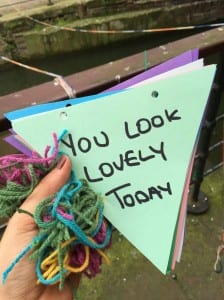“A large part of the work has to do with researching a place, often an unusual one that is imbued with history or permeated with atmosphere” (Pearson, 2010, 7)
Framing Statement:
We began our process by conducting historical research in and around Lincoln high street. We found a lot of interesting information about Stokes café, a Tudor building in the middle of the high street. This research eventually led us to our site – the two walkways either side of the Brayford behind stokes café.

Most of the history around this area was negative. Our initial idea was to look at how the Glory Hole was “often referred to as the ‘Murder Hole’” (Santos, 2013) because it was the place to dispose of dead bodies. This made us consider Wrights and Sites and their ‘misguides’ practice. However once we discovered the area around the Glory Hole used to be a boat market, a bustling social area, we began to think differently about our site. Our own personal opinions and experiences walking through this area were mostly negative we believed this may be the case for many other people around the city. The idea of it being a vibrant place where people would go and interact with each other intrigued us and we wanted to bring that back. We thought about Marc Augé and his ideas about ‘places’ and ‘non-places’. We all thought of the Glory Hole as a ‘non-place’. It was never a destination for us simply a walkway, a means of getting to a ‘place’ – the high street. Our aim was to transform the Glory Hole from its current ‘non-place’ state to its original anthropological glory. We looked heartily to our marketplace research for inspiration. We moved from Wrights and Sites to Marcia Farquhar. Specifically we were influenced by her ‘A Live Art Tour’ .
We wanted the basic concept of people being lead around London to various sites and experiences to create a miniature version around the Glory Hole. We used our research to create multiple stations and points of interest on either side of the Glory Hole for our audience passers-by to visit. After running the whole piece in its entirety we found it did not give off the desired effect. We stripped the idea back to its basic principles ‘exchange’, ‘celebration’, and ‘connection’ in order to create our final piece. Our performance lasted just over one hour and remained at the back of Stokes café for the entire time. We got to the site early to cover it in wool (our method of connecting both sides of the Brayford) at around 10am and our performance began at 11am. We created a system of moving compliments in bottles through the Brayford and then passing the compliments across the Brayford using wool. These compliments were then offered to our audience members or put on our compliment bunting.

Analysis of Process
The start of our process was largely focused on looking for interesting pieces of historical information. Mike Pearson describes site-specific art as “engag[ing] intensively with the history and politics of that [site] and with the resonance of these in the present” (Pearson, 2010, 9). We were first drawn to our site the Glory Hole by an article we found in the Lincolnite where we discovered it had a dark and horrible past. The article explained how the Glory Hole was once referred to as the ‘Murder Hole’ because when “a body was thrown in the Witham, it would often be washed ashore either under, or near the bridge.” (Santos, 2013). This piece of research lead us to consider creating a tour around the Glory Hole and around the high bridge based on gruesome fictional tales of some of the murders that may have happened there. However we quickly moved away from this idea when we discovered “in medieval times the bridge was an important centre for merchants” (Stokes tea and coffee, 2014). This idea of a ‘boat market’ interacting with the people of Lincoln around the Glory Hole really changed our view of our site. The ‘Murder Hole’ article although quite shocking matched our negative ideas and experiences of the Glory Hole. The boat market, on the other hand, completely changed the way we thought of the Glory Hole. It was described as “swarming with life and activity” (Stokes tea and coffee, 2014) completely the opposite to how we felt it is today. It reminded us of Marc Auge’s ideas around place and non-place. He describes ‘non-places’ as being
“spaces which themselves are not anthropological” (Auge, 1995, 78)
We decided we wanted to try and return the Glory Hole to the status of ‘Place’. A place of interaction between people instead of a means of getting to the high street. With the idea of a busy marketplace in mind we turned to Marcia Farquhar’s A Live Art Tour (REcreativeUK, 2012). In this piece of site-specific art Farquhar conducts a tour around London to a range of destinations linking to the Battle of Britain. At every destination there was something new to see and interact with for the audience members. We wanted to try and make this on a smaller scale around the Glory Hole. We took the idea of the boat market selling wares to people on the walkway and decided to create our own exchange using goods they may have sold these include, wool, meat, and fruits. We decided we would use the wool to connect to the railings either side of the water. One at pedestrian level and the other at the midpoint of some steps leading to the top of Stokes cafe.
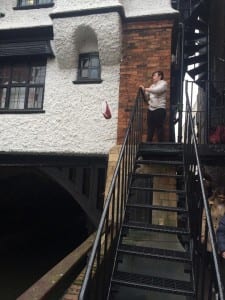
Once we had permission from the cafe to use the steps we practiced this method of transporting goods from one side to the other to find it was very effective and looked very visually interesting as well. We decided we would hand fruit out to members of the public as the boats would have done. We were also drawn to the idea of “porters stand[ing] around waiting to be hired” (Stokes tea and coffee, 2014) we thought it might be an interesting section of our piece to have some volunteers come and stand holding signs on a section of the walkway that was not accessible to the public.

Another element of Farquhar’s tour that influenced us was the idea of handing cups of juice out to the audience. Instead of the lemonade Farquhar provided we wanted to hand out orange juice as we felt this fruit had closer links to the market we wanted to recreate. We liked the idea of squeezing fresh oranges with our hands to make the juice and experimentedwith the idea of dragging the oranges through the water. This dragging motion was really nice to watch and their was something very intense about squeezing the oranges by hand.

Another interesting piece of history we found on the Stokes website talked about “a celebration dance [that] was held under the bridge” (stokes tea and coffee, 2016) on top of planks that were placed over the river. We felt this connection of the two sides really resonated with our ideas so far and wanted to somehow include this dance as a section of our piece. We initially wanted to replicate the dance by getting planks of wood but this became too impractical so we scrapped the planks but kept the dancing. We practiced with various pieces of medieval music until we found one we liked.
We wanted to make the Glory Hole feel like a place of celebration. A place of interaction where we would talk to people and exchange our goods with them. It was only once we put all of these elements together for the first time we discovered it didn’t feel like that at all. The dancing was too uncomfortable for members of the group and it showed. It was also much harder than we thought to hand out pieces of free fruit to people and so very little exchange happened. The whole thing felt too fragmented and therefore did not create the buzzing atmosphere we first hoped for. The visual aspects of it where still very successful so we wanted to increase the amount of wool from just one line to cover the walkway as much as we could. The dragging element in the orange section also looked visually interesting but the orange juice stall itself was too isolated from the rest of the group. We realised we had stuck too closely to our historical research and it just didn’t work. We decided to strip back everything we had done so far to the key elements that we were trying to make: celebration, exchange, and connection. By increasing the wool we felt we increased the connection between both walkways. We still wanted the exchange to happen across the water but the fruit simply did not work. Instead we moved to compliments and moving the compliments through the water instead of the oranges. If the
“non-place … promotes solitude rather than social relations” (Govan, 2007, 127)
then we wanted to make create as many social interactions as we could. When we tested handing out compliments we found people were so much happier to receive them and speak to us compared to when we were trying to hand out fruit.
Evaluation:
On reflection I think if we could start the whole process again we would still look as deeply into the history of the place as we did but not get so tied up in the technicalities of it. Although history is a great way of getting into a site it had too much influence over us while we were making our piece. We may have come up with something much more our own if we had allowed ourselves more creative license with the research we had conducted. For our final performance Shannen and Tabby would walk up and down either walkway dragging a glass bottle tied with wool in the Brayford behind them. As audience members made their way to the performance area Shannen and Tabby would place rolled up triangular pieces of card into the bottles. They then walked these bottles toward the Stokes café where myself, Roxy and Alex were standing. Shannen and Tabby would pull the bottle out of the Brayford and hand us the unravelled pieces of card. One or more of us would then attach the piece of card to a wool line stretching across the Brayford and the person over the other side would pull it over to them. They would then show the piece of card to a member of the public revealing the compliment it had written on it.
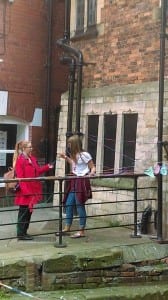
The audience member then had the option to keep the compliment or allow us to hang it as bunting over the ‘Glory Hole’. This sequence was repeated for the entirety of our performance. Not all of the passers by opted to take part in our performance however we did have a great deal of people who were very interested in what we were doing and were delighted to receive a compliment from us. One man was very excited by the whole idea and requested his girlfriend receive one as well. He also asked if he could attach the bunting to the wool line himself. This was not something we had at all expected an audience member to do and it was a great feeling to see he was so intrigued by our performance. Setting up the wool across and up and down the Brayford attracted almost as much attention as the actual performance itself. Many people would stop and ask us what we were doing and take photographs almost as many people that interacted with us in the final performance.
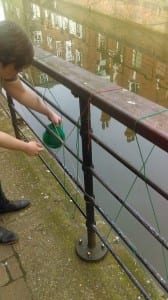
This made us wonder if we had missed a performative element of this section alone as it seemed to reach a lot of people. Perhaps instead of speedily wrapping the wool around the railings trying to get set up our performance as fast as we could we should have made more of this element and really made it part of performance. In the actual performance I think the wool element worked particularly well and was the most successful part of our piece. People joining the walkways could see it from very far away and I think it looked particularly striking. This was the main element that attracted audience members to interact with our performance. One element that didn’t work as well as we had practiced was dragging the water bottles up and down the Brayford to transport the compliments.Unfortunately in practice the walkways were very quiet and there were few passers-by so we were able to keep up the pace and give almost everyone a compliment. On the actual day of our performance there were a great deal more people using the walkways and the message in a bottle method was too slow for the amount of people walking by. If we could do the performance again I think we would re-think this particular element, so that we could hand out compliments much faster than we did. This lack of pace detracted from the overall celebratory feeling we were trying to create. However, I feel we did create a positive atmosphere in the Glory Hole and succeeded in making it an anthropological ‘place’ of interaction and exchange. If site specific art is about
“changing the way people perceive places” (Pearson, 2010, 9)
then I believe we succeeded.
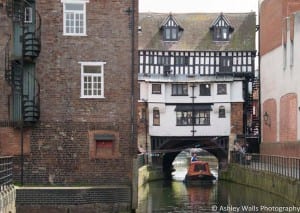
Bibliography
- Auge, M. (1995) Non-Places Introduction to an Anthropology of Supermodernity. London: Verso Books.
- Govan, E. (2007) Making a performance: devising histories and contemporary practices. London: London Routledge.
- Martikainen, A. (2013) Medieval RPG town music – a day at the market. Available at: https://www.youtube.com/watch?v=Z4cyGbV4nmw [Accessed on: 13 May 2016]
- Pearson, M. (2010) Site-Specific Performance. London: Macmillan Palgrave.
- REcreativeUK (2012) Marcia Farquhar – A live art tour. Available at: https://www.youtube.com/watch?v=1Li90TEcsUw [Accessed on: 13 May 2016]
- Santos, C. (2013) The High Bridge to Lincoln’s Past. The Lincolnite. [online] Available at: http://thelincolnite.co.uk/2013/10/the-high-bridge-to-lincolns-past/ [Accessed: 13 May 2016]
- Stokes tea and coffee (2014) the history of high bridge. Available at: http://stokes-coffee.co.uk/history-high-bridge/ [accessed on: 13 May 2016]
